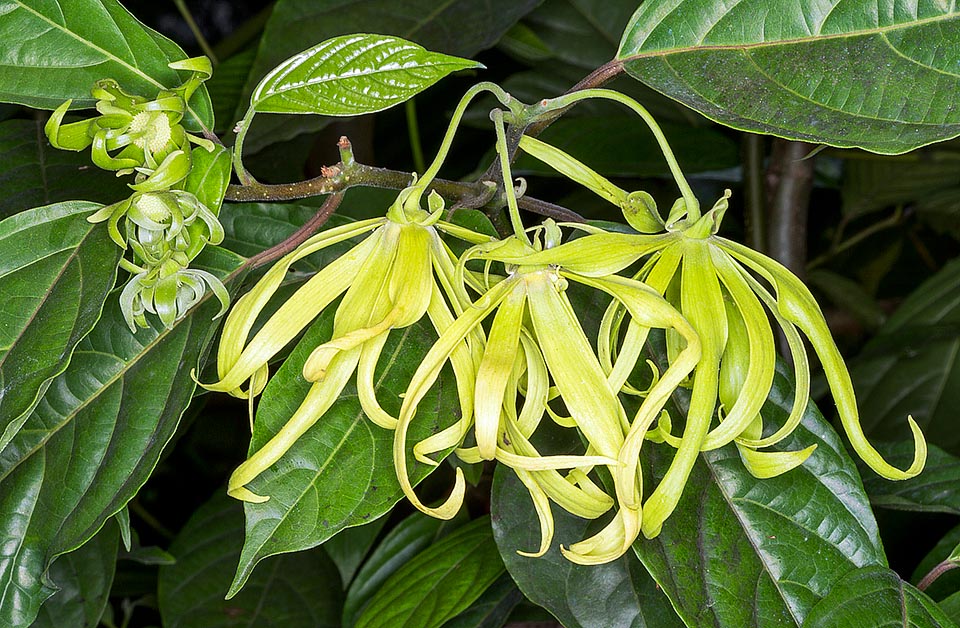Family : Annonaceae

Text © Pietro Puccio

English translation by Mario Beltramini
The species is native to tropical Asia (Cambodia, Indonesia, Laos, Malaysia, Myanmar, Papua New Guinea, Philippines, Thailand and Vietnam), where it grows in the humid forests from the sea level up to about 1000 m of altitude in the equatorial zones.
The name of the genus comes from the Indonesian one, “Kananga”; the name of the species is the Latin adjective “odoratus, a, um” = perfumed, odorous, with obvious reference.
Common names: Macassar oiltree, perfumetree, ylang-ylang tree (English); canang odorant, ilang-ilang (French); kananga, kenanga (Indonesian); ylang-ylang (Italian); cananga, ilanga (Portuguese); cadmia, cananga, ilang-ilang (Spanish); Ylang-ylangbaum (German).
The Cananga odorata (Lam.) Hook.f. & Thomson (1855) is an evergreen tree, 10-30 m tall, also if, in cultivation, it is kept at a lower height for facilitating the collection of the flowers, with cylindrical trunk, of up to about 50 cm of diameter, with smooth and greyish bark and long branches usually drooping. The leaves, on a 1-2 cm long petiole, are alternate, simple, usually distichous, oblong-elliptic with pointed apex and wavy margins, 8-22 cm long and 4-12 cm broad, of intense green colour, glabrous or slightly pubescent.
The inflorescences, on short axillar buds without leaves, are drooping racemes, on a 0,3-0,5 cm long peduncle, carrying 4-12 bisexual flowers drooping on pedicel 1-5 cm long. The flowers present three ovate, 0,6 cm long, sepals, six petals linear to linear-lanceolate, usually wavy or curved, up to about 8 cm long and 0,5-1,5 cm broad, initially of greenish yellow colour, then, when ripe, intense yellow with a purple brown spot at the inner base, numerous stamina and gynoecium formed by 7-15 free carpels; the flowers emit their intense scent when ripe, after 15-20 days from the opening. The fruit is a cluster formed by various separate ovoid monocarps, 1,5-2,5 cm long and 1,5 cm of diameter, of dark green colour tending to black when ripe, containing 2-12 ovoid seeds compressed laterally, about 0,8 cm long, 0,6 cm broad and 0,3 cm thick, immersed in a yellowish oily pulp. It usually reproduces by seed, previously kept in water for one day, often directly interred in order not to cause damage to the long taproot in the transplants, put at a depth of 2-3 cm, with germination times of 2-3 months; in the equatorial zones and at sea level the first flowering takes place by around the second year of age, the times get remarkably longer (6-10 years) in the cooler climates.

Native to tropical Asia, the Cananga odorata is a vigourous fast growing evergreen thay may reach the 30 m of height. From the very scented inflorescences, collected at sunrise, they get an essential oil. Bark and flowers are utilized in the traditional medicine for various pathologies and the oil in aromatherapy © Giuseppe Mazza
The propagation by cutting usually gives very low percentages of success, whilst they are high by grafting if as graft carriers are used plants of about 7 months of age.
Fast growing tree, but which, in cultivation is kept with appropriate pruning at a height not exceeding the 3 m, which has a remarkable importance in the customs and traditions of many tropical countries, due to the flowers with intense scent, as well as economic, due to the essential oil extracted from them, whose collection at the tropics takes place practically during the whole year. Cultivable in full sun in the humid tropical and subtropical climate zones with average annual temperatures of 20-28 °C, does not stand temperatures less than +5 °C, and rainfall well distributed during the year as does not tolerate long drought periods; it is not particular for what the soil is concerned, even if it prefers the sandy and volcanic ones, acidic or neutral. It is often planted in the familiar gardens, in particular in south-eastern Asia and in the Pacific islands, where the flowers are used for garlands, ornament, for perfuming the ambients and in various religious and civil ceremonies.
The flowers contain 1-2% of essential oil which is extracted by distillation in steam current from the fresh flowers harvested at dawn, when the contents of oil is maximum, whose main components giving the characteristic perfume are eugenol, iso-eugenol and para-cresol. The oil has an ample utilization in the industry of the perfumes, of the soaps and of the cosmetics, even if it presents some risk of allergic reactions, it is also utilized to aromatize bakery products, candies, jellies and drinks; united with the coconut oil it takes the name of Macassar oil, used since long time in south-eastern Asia for treating the hairs. The wood, little durable, is locally used for small boats, furniture, various objects and as fuel. Bark and flowers are utilized in the traditional medicine for various pathologies and the oil in aromatherapy.
In the tropical gardens is often cultivated the Cananga odorata var. fruticosa (Craib) J. Sinclair (1951), which looks as a 1-1,5 m tall shrub with copious and almost continuous flowering.
Synonyms: Fitzgeraldia mitrastigma F.Muell. (1867); Unona odorata (Lam.) Baill. (1868); Cananga scortechinii King (1892); Canangium odoratum (Lam.) King (1892); Canangium scortechinii King (1892); Cananga odorata var. velutina (Blume) Koord. & Valeton (1903); Cananga mitrastigma (F.Muell.) Domin (1925); Canangium mitrastigma (F.Muell.) Domin (1925).
→ To appreciate the biodiversity within ANNONACEAE family and find other species, please click here.
